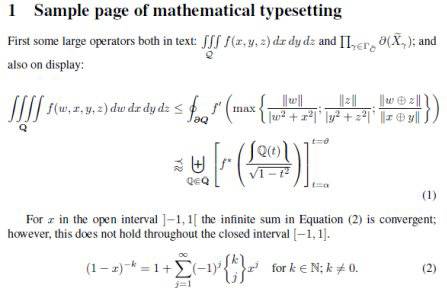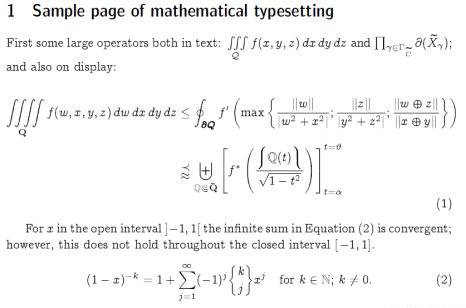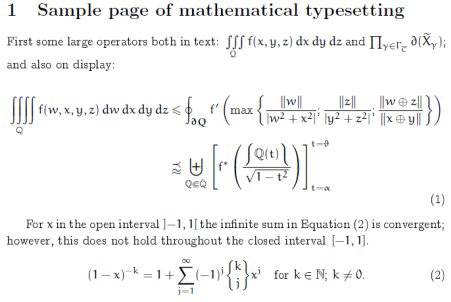字体一: 设置实验代码如下: 字体二: 设置实验代码: 字体三: 实验设置代码:
\documentclass{article}
\pagestyle{empty}
\usepackage{times}
\setcounter{page}{6}
\setlength\textwidth{351.0pt}
\setlength\textheight{.44\textheight}
\usepackage{amsmath,amssymb}
\newcommand\ibinom[2]{\genfrac\lbrace\rbrace{0pt}{}{#1}{#2}}
\usepackage{bm}
\begin{document}
\section{Sample page of mathematical typesetting}
First some large operators
both in text: \( \iiint\limits_{\mathcal{Q}}
f(x,y,z)\,dx\,dy\,dz \) and
\(\prod_{\gamma\in\Gamma_{\widetilde{C}}}
\partial(\widetilde{X}_\gamma)\); and also on display:
\begin{equation}
\begin{split}
\iiiint\limits_{\mathbf{Q}} f(w,x,y,z)\,dw\,dx\,dy\,dz&\leq
\oint_{\bm{\partial Q}} f' \left( \max \left\lbrace
\frac{\lVert w \rVert}{\lvert w^2 + x^2 \rvert} ;
\frac{\lVert z \rVert}{\lvert y^2 + z^2 \rvert} ;
\frac{\lVert w \oplus z \rVert}{\lVert x \oplus y \rVert}
\right\rbrace\right)\\
&\precapprox \biguplus_{\mathbb{Q} \Subset \bar{\mathbf{Q}}}
\left[ f^{\ast} \left(
\frac{\left\lmoustache\mathbb{Q}(t)\right\rmoustache}
{\sqrt {1 - t^2}}
\right)\right]_{t=\alpha}^{t=\vartheta}
\end{split}
\end{equation}
For $x$ in the open interval \( \left] -1, 1 \right[ \)
the infinite sum in Equation~\eqref{eq:binom1} is convergent;
however, this does not hold
throughout the closed interval \( \left[ -1, 1 \right] \).
\begin{align}
(1 - x)^{-k} &=
1 + \sum_{j=1}^{\infty} (-1)^j \ibinom{k}{j} x^j
\text{\quad for $k \in \mathbb{N}$; $k \neq 0$.}
\label{eq:binom1}
\end{align}
\end{document}
\documentclass{article}
\usepackage{times}
\pagestyle{empty}
\setcounter{page}{6}
\setlength\textwidth{351.0pt}
\setlength\textheight{.44\textheight}
\usepackage{amsmath,amssymb}
\newcommand\ibinom[2]{\genfrac\lbrace\rbrace{0pt}{}{#1}{#2}}
\usepackage[boldsans]{ccfonts}
\usepackage{bm}
\begin{document}
\section{Sample page of mathematical typesetting}
First some large operators
both in text: \( \iiint\limits_{\mathcal{Q}}
f(x,y,z)\,dx\,dy\,dz \) and
\(\prod_{\gamma\in\Gamma_{\widetilde{C}}}
\partial(\widetilde{X}_\gamma)\); and also on display:
\begin{equation}
\begin{split}
\iiiint\limits_{\mathbf{Q}} f(w,x,y,z)\,dw\,dx\,dy\,dz&\leq
\oint_{\bm{\partial Q}} f' \left( \max \left\lbrace
\frac{\lVert w \rVert}{\lvert w^2 + x^2 \rvert} ;
\frac{\lVert z \rVert}{\lvert y^2 + z^2 \rvert} ;
\frac{\lVert w \oplus z \rVert}{\lVert x \oplus y \rVert}
\right\rbrace\right)
\\
&\precapprox \biguplus_{\mathbb{Q} \Subset \bar{\mathbf{Q}}}
\left[ f^{\ast} \left(
\frac{\left\lmoustache\mathbb{Q}(t)\right\rmoustache}
{\sqrt {1 - t^2}}
\right)\right]_{t=\alpha}^{t=\vartheta}
\end{split}
\end{equation}
For $x$ in the open interval \( \left] -1, 1 \right[ \)
the infinite sum in Equation~\eqref{eq:binom1} is convergent;
however, this does not hold
throughout the closed interval \( \left[ -1, 1 \right] \).
\begin{align}
(1 - x)^{-k} &=
1 + \sum_{j=1}^{\infty} (-1)^j \ibinom{k}{j} x^j
\text{\quad for $k \in \mathbb{N}$; $k \neq 0$.}
\label{eq:binom1}
\end{align}
\end{document}
\documentclass{article}
\usepackage{times}
\pagestyle{empty}
\setcounter{page}{6}
\setlength\textwidth{351.0pt}
\setlength\textheight{.44\textheight}
\usepackage{amsmath,amssymb,ccfonts}
\newcommand\ibinom[2]{\genfrac\lbrace\rbrace{0pt}{}{#1}{#2}}
\usepackage[euler-digits]{eulervm}
\usepackage{bm}
\begin{document}
\section{Sample page of mathematical typesetting}
First some large operators
both in text: \( \iiint\limits_{\mathcal{Q}}
f(x,y,z)\,dx\,dy\,dz \) and
\(\prod_{\gamma\in\Gamma_{\widetilde{C}}}
\partial(\widetilde{X}_\gamma)\); and also on display:
\begin{equation}
\begin{split}
\iiiint\limits_{\mathbf{Q}} f(w,x,y,z)\,dw\,dx\,dy\,dz&\leq
\oint_{\bm{\partial Q}} f' \left( \max \left\lbrace
\frac{\lVert w \rVert}{\lvert w^2 + x^2 \rvert} ;
\frac{\lVert z \rVert}{\lvert y^2 + z^2 \rvert} ;
\frac{\lVert w \oplus z \rVert}{\lVert x \oplus y \rVert}
\right\rbrace\right)\\
&\precapprox \biguplus_{\mathbb{Q} \Subset \bar{\mathbf{Q}}}
\left[ f^{\ast} \left(
\frac{\left\lmoustache\mathbb{Q}(t)\right\rmoustache}
{\sqrt {1 - t^2}}
\right)\right]_{t=\alpha}^{t=\vartheta}
\end{split}
\end{equation}
For $x$ in the open interval \( \left] -1, 1 \right[ \)
the infinite sum in Equation~\eqref{eq:binom1} is convergent;
however, this does not hold
throughout the closed interval \( \left[ -1, 1 \right] \).
\begin{align}
(1 - x)^{-k} &=
1 + \sum_{j=1}^{\infty} (-1)^j \ibinom{k}{j} x^j
\text{\quad for $k \in \mathbb{N}$; $k \neq 0$.}
\label{eq:binom1}
\end{align}
\end{document}
投稿

微信公众账号
微信扫一扫加关注
评论 返回
顶部



发表评论 取消回复